Trail Running Shoes
If the Shoe Fits: A Buyers' Guide to Trail Running Shoes
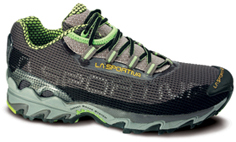
Choosing the right trail running shoes, or trail runners, is critical for a positive running experience. Trail runners are about function, not fashion. So, before you punch in your credit card number on your favorite outdoor retailer’s website, or randomly choose a shoe off the wall at your local sporting goods store, consider the features of the various trail running shoes on the market, as well as the unique nature and biomechanics of your feet.
Contents
Know Your Feet
Like feet, trail runners come in all shapes, sizes, and stability levels.
First, take a look at your feet. Are they wide or narrow? Are your arches high or flat? (See foot types below.) Do you run or walk on the outsides or insides of your feet? There is a continuum of running shoes, from the neutral cushioning category, to the moderate stability category, to the high stability category.
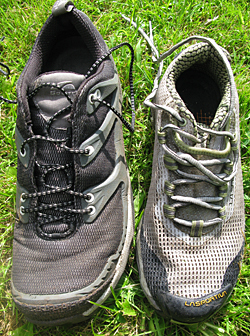
Trail runners come in a variety of shapes, sizes, and stability levels.
Stability, aka arch support, is the amount of rigidity in a shoe and is one of the most important considerations in selecting a running shoe. Knee pain, shin splints, and plantar fasciitis oftentimes signal a need for more stability. Conversely, shoes with too much stability can force a runner to the outsides of their feet, causing ankle pain.
If you have a running store nearby, a knowledgeable staff member will be able to examine your feet and watch you walk and run. By checking your gait, it becomes apparent whether you over-pronate, supinate/under-pronate, or neither, thus directing you to a shoe with the proper amount of stability.
Over-pronation means rolling your foot inward while walking or running. It occurs when the heel strikes first and then rolls overly inwards to toe-off. This can create torque on the lower leg with each foot strike. Some slight pronation is normal.
In general, the flatter the foot, the more likely a person is to over-pronate. Flat feet are more flexible, thus requiring a shoe that can control that inwards motion of the foot. Added stability in a shoe helps to support the arch and guide the foot in a straightforward motion. If the over-pronation is minimal, a “moderate stability” shoe will suffice. For more severe over-pronation, look for a “high stability” shoe.
Supination, or under-pronation, means rolling your foot and ankle outward while walking and running. It is characteristic of feet with high arches. This type of foot has a more defined structure, causing the runner to walk on the outsides of his or her feet. Since this is the most rigid part of the foot, this type of runner needs a shoe that is more flexible. These shoes are referred to as “neutral” or “cushioning” shoes. By nature, trail running shoes tend to be stiffer because they need to protect the feet on more challenging terrain. Folks that supinate simply will want to look for a more flexible trail running shoe.
If you don’t have a local expert to diagnose your gait and foot type, try the wet foot test. Get the bottoms of your feet wet and step on a piece of newspaper or paper towel. Compare your wet footprints to the foot types in the chart below. This will help you determine whether you have a high, low, or neutral arch. A flat foot will leave a complete print of the foot, while a high-arched foot will only imprint the forefoot, the heel, and perhaps a bit of the outside edge.
Also, take a look at the wear patterns on the soles of an old pair of running or walking shoes. If you tend to wear down the inner edges of the bottom of the shoe, you likely over-pronate. If you grind down the outside edges, you supinate. Wear in the middle indicates a neutral arch.
Know the Terrain
Next, consider the type of trails and terrain you’ll be tackling.
Kathy Hobbs, executive director of the American Trail Running Association and manager of the Teva U.S. Mountain Running Team, suggests that you “consider the terrain that you will be running and go to a specialty shoe retailer and get their advice on what shoe meets your needs.” You should also consider any injuries past or present when selecting a shoe.
While some runners may get away with using their regular jogging skins from running the roads, you are best off getting a pair of trail-running specific shoes. “Road shoes are meant for a foot strike that is relatively the same over time and distance,” says Hobbs. “Trail shoes are for the uneven, unpredictable, changeable nature of the terrain.”
The various types and models of trail running shoes can seem daunting. Hobbs lists the following shoe features as the most important when considering your needs:
-
Side-to-side support: shoes should give both medial support, toward the arch, and lateral, toward the outside of your foot.
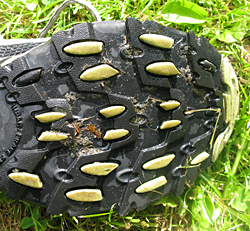
Deep lugs and sticky outsoles make for excellent traction on trails. - Torsional stability and support: for midfoot support and to control over-pronation and supination.
- Sole lugs for grip: trail surface will play a role in your choice. Dirt, grass, or woodchip trails are less severe, requiring only modest tread. Rockier trails call for deeper, more aggressive lugging. Some shoes tout sticky rubber outsoles for added traction.
- A porous upper that lets water out quickly. For very wet and muddy conditions, some trail runners offer a waterproof liner and polyurethane webbing to keep your feet dry.
Keep an eye out for shoes with a gusseted tongue and wrap-around lacing, both make for a snugger fit, keeping out trail debris. Match your shoe’s features to the terrain you expect to encounter regularly and your needs.
Know if the Shoe Fits
Now you’ll need to try shoes on. If you are new to trail running, be prepared for trail runners to feel a bit foreign, even if you are accustomed to road running shoes. Trail runners have a lower profile, giving you the sense that you are closer to the ground and better able to feel the earth beneath your feet. Being aware of the ruts and roots on the trail will help you respond appropriately. Trail runners also have wider bases and more aggressive treads.
Hobbs says “consider fit and feel when testing a shoe and if it feels good, provides appropriate support, and good grip.” If the shoe fits, it will feel snug and boot-like in the back, anchoring your heel in, and more like a sandal up front, allowing your toes to wiggle around.
Be sure you have 1/4 to 1/2 inch at the toe end of the shoe to allow for some swelling room. The longer the run, the more your feet will swell. Hobbs emphasizes the importance of sizing, saying that you will “typically need a half size bigger than your street shoes to make sure your toes don’t smash up to the toe box.” It’s the best way to avoid those nasty black and blue toenails.
In the end, you want to pick a trail runner that feels natural on your feet. You shouldn’t be excessively aware of the shoe. If you are, it may not be right for you.
Once you hit the trails you’ll be glad you chose a shoe that fits properly and has all the features necessary for your trail running adventures. A new pair of kicks can make all the difference in creating a successful and fun trail running experience.
The Best Trail Running Shoes
On This Page
Top Picks
How we choose: The best trail running shoes highlighted here were selected based on 1,348 reviews of 352 products. Our top picks are those that are readily-available in the United States and have received the highest overall ratings from reviewers.
How we test: Trailspace is powered entirely by our community of readers. The reviews posted here reflect the real-world experiences of outdoor enthusiasts just like you.
If you've used a trail running shoe that you think should be listed here, please share your experience.
Disclosure: Trailspace never accepts payment for gear reviews, product placement, or editorial coverage. When you buy through affiliate links on our site, Trailspace may earn a small commission, which helps cover the costs of running the site.
Altra Superior 4.0
The Superior 4.0 is a supremely comfortable shoe, with many improvements over its predecessors (better fit, materials, flexibility). Yet the 4.0 maintains most of the best characteristics that make this model my favorite hiking shoe. They are responsive to the trail, fit my narrow feet perfectly, and the tread is excellent for gripping loose gravel and even snowy patches. They are lightweight and dry fast. My only disappointment is that they did not last quite as long as my Superior 3.0/3.5s.
Reasons to Buy
- Comfortable and great fit for narrow feet, while still maintaining wide foot-box for toe-spread and foot-swelling
- Lightweight and minimalist
- Flexible sole
- Breathable, stretchy upper that conforms to foot shape
- A great choice for thru-hiking
- Bonus removable rock-plate (StoneGuard)
Reasons to Avoid
- Slightly less durable than Superior 3.0/3.5s (separated at the sole/upper seam at inside midfoot at 500 miles=blowouts)
- Easily allow water inside (also dry fast)
Description & Specs: The Superior 4.0 is the most recent version of Altra's low profile trail running shoe. The 4.0s have been updated quite a bit from the 3.0/3.5 version, with the goal of producing a lighter, grippier, and sleeker shoe. Superiors will probably appeal to those that value minimalist performance such as good trail feel and sensitivity, low-to-the-ground stability, and a streamlined, lightweight profile. Weight (of my sample pair, size women’s 9.5): 14 oz. (w/out removable StoneGuard) Heel-to-Toe Drop: 0 mm (Note: most all of Altra's shoes are zero-drop, which means they have the same height in the heel as in the rest of the shoe) Stack height: 21mm Multi-point attachments for use with trail gaiters Disclaimer: Writing...
Read more: Altra Superior 4.0 reviews (2)
Vibram FiveFingers KSO
As a children how many of us did not need any shoes and were happy running around barefoot even if it meant to get some blisters here and there? Later on, when we had to put shoes on and go to school and then work and so on, things changed and it would be considered inappropriate to one day show up without any shoes on. I wonder how many of us feel happy with what they are wearing on day to day basis on their feet and how many of us is actually comfortable?The Vibram soles is revolutionary innovation as far as comfortable shoes can be, which is based on the age old methodology that being barefoot helps your balance and will make you feel aware of the nature around and ground beneath your feet.
Read more: Vibram FiveFingers KSO reviews (18)
La Sportiva Bushido II
The La Sportiva Bushido II is a solid, comfortable trail running shoe for all-around, year-round use on trails and mountains. With excellent traction and fit, it retains everything I loved about the original Bushido trail runner with some minor refinements.
Reasons to Buy
- Comfort and fit
- Traction
- Durability
- Works well for trail running or hiking
- Comfortable in year-round temps
- Cushion and stability adequate for most trail use
Reasons to Avoid
- For technical runs and hikes, I'll switch to a shoe with more cushion and stability
- No waterproof/GTX version
- Costs $130, but the price has remained the same from previous versions and is comparable to other shoes
When I heard that La Sportiva was introducing an updated Bushido II trail runner my first response was "No!" What if they screwed something up? I've worn at least six pairs, possibly more, of the original La Sportiva Bushidos over the five years since they launched. That totals well over a thousand miles, probably double, by my rough guesstimate. While I also have road running shoes for pavement and own a few other pairs of trail runners, not to mention hiking footwear, the Bushidos are my go-to, everyday pair for when dirt, rocks, mud, and snow are underfoot here in Maine. I rarely think about these shoes.
Read more: La Sportiva Bushido II review (1)
Salomon XA Pro 3D
Salomon’s XA Pro 3D is a heavy duty trail running shoe that has been around, with various updates, for years. It is very heavy and firm for a running shoe, and I use it as a low light hiker. It’s available with a waterproof/breathable membrane, but I like the no-membrane version for it’s very good breathability. Very good traction, support, foot protection, and durability, plus an interesting lacing system, make this a winner. The non-waterproof version’s availability in wide sizing was fortuitous for me, as the regular version was too narrow for my feet.
Reasons to Buy
- Unusual but effective lacing system
- Vents sweat well
- Waterproof/breathable version available
- Lots of support
- Solid, grippy sole
- Width sizing
- Nice features
Reasons to Avoid
- Heavier than typical trail running shoe
- Very firm midsole might not suit some people
- Relatively expensive for a trail runner
Basic Information The pair weighed 2.2 pounds out of the box, including the light insoles that I discarded. The guy who built my latest pair of custom orthotics recommended this shoe for its relatively firm and more supportive midsole, and I always wear them with the orthotics. The shoe requires break-in because it is so solid; it takes some time to get used to the firmness of the shoe. More on that in a bit. These are on the heavy end of the spectrum for trail running shoes, and also on the more expensive end at $130 full price.
Read more: Salomon XA Pro 3D reviews (11)
Brooks Cascadia
Brooks continues to stand on the podium with this high-quality trail runner. Offering ample room in the forefoot while still holding perfectly secure, the Cascadia 16 provides the wearer with a lightweight shoe that has excellent under-foot protection. This lightweight shoe is best suited for the hiker/trail runner that needs great traction and support on groomed trails, rough terrain, or anything in between. The Cascadia 16 is available for both men and women as a waterproof (GTX) or well ventilated, regular model.
Reasons to Buy
- Outstanding rock shield
- Stable/comfortable fit
- Roomy forefoot
Reasons to Avoid
- Not the best grip in wet/slippery conditions
- Main face fabric may have questionable long-term durability
Although finding the perfect trail shoe may sometimes feel like chasing a "glass slipper," the Brooks Cascadia 16 checks many of the boxes… Without a doubt, the venerable Brooks Cascadia is one of the ‘tried & true’ products that has been around the block. Currently in its 16th generation, the Cascadia always seems to be reaching for new improvements. These trail runners are ideal for lightweight/ultralight backpacking, when saving weight is a priority. Using the Brooks Cascadia 16 under loads up to 25 lbs feels comfortable on a week-long summer backpacking trip. Specifications: Price: $130 ($160 GTX) Men's and Women's separate lines Weight: 298g/10.5oz per men's shoe; 319g/11.25oz actually recorded weight without insole,...
Read more: Brooks Cascadia reviews (19)
La Sportiva Wildcat
A sturdy trail runner fit for lightweight backpacking. The outsole on this shoe is the best thing since the old Vibram soles on my heavy full-leather boots. They stick to every condition I've encountered on the Appalachian Trail (except for mossy wet rock, but everyone is going to break their neck on that stuff). Lightweight and breathable. If the shoe fits, wear it!
Reasons to Buy
- Outsole/lugs
- Breathable
- Heel cup
- Dries fast
Reasons to Avoid
- Durability
After 15 years backpacking in heavy, full leather, boots, I finally decided to give a trail runner a try. I wish I had switched sooner. The differene between having 2 lb boots on each foot vs. this 12 oz shoe is amazing! Here's the bad news, these shoes will not last as long as a leather boot. The inside of the shoe at the top of where you insert your foot is starting to wear after only about 80 miles of backpacking and trail running. But, that's the only place where I think they are wearing too soon.
Read more: La Sportiva Wildcat reviews (8)
Xero Shoes Mesa Trail II
A minimalist trail runner with great traction. It claims to be very durable, and has held up well so far.
Reasons to Buy
- Wide toe box
- Minimalist with the ability to use without the insole
- Lightweight
- Great traction
- Durable
Reasons to Avoid
- Minimal padding
- I run slower in them when footing isn't so great
- I can feel the lugs when running on pavement
This is how they look after over 80 miles of use on and off trail Fit: They fit me well with a wide toe box. Comfort: Flexible and feels great right out of the box. Support: It's a minimalist shoe, so it's not going to have much support. Water Resistance: N/A Traction: I've used it in snow and on a muddy hill with better than expected results. I have slipped a little, but I've even slipped in my metal studded VJs on some surfaces. Temp Control: They are mesh with reinforced sections.
Read more: Xero Shoes Mesa Trail II review (1)
INOV8 Roclite G 345 GTX
The Inov-8 Roclite G 345 GTX is a very high quality mid-ankle boot that offers superb traction, while still being very lightweight. Inov-8 classifies this product as a hiking and running boot that provides comfort and traction over trail protection. Graphene rubber technology takes this footwear to a new level, making it ideal for unstable and slippery terrain during moderate mileage days.
Reasons to Buy
- Incredible traction even on wet mossy rock
- Comfortable
- Durable outsole
- Gaiter compatible (proprietary)
Reasons to Avoid
- Toe cap/heel cap insufficient against stones
- No protection on outer foot area
- Laces are slippery to use
- Wide openings catch debris
Inov-8 released the Roclite G 345 GTX to meet the needs of the "fast & light" hiker or trail runner looking for exceptional waterproof comfort. Inov-8 claims "superior traction" with this boot, and it was found not only to be accurate, but perhaps the best traction of any boot I've tested. Although several features help these boots shine, they are straightforward, allowing the wearer to focus on the trail ahead. These boots were tested over approximately 150 miles, without the traction giving in a bit.
Read more: INOV8 Roclite G 345 GTX review (1)
INOV8 Trailfly G 270
A rugged trail shoe with a long lifespan. Graphene-enhanced rubber ousole gives good grip and long life.
Reasons to Buy
- Long-lasting uppers and sole
- Good fit
- Good grip
- Zero drop
- Good trail feel
Reasons to Avoid
- Not especially light
- No shoe lasts forever...
I guess I must really like these shoes, because I bought a second pair! 2024 model with about 600 km (L), 2023 model with 1100+ km (R) I put over 1100 km (700 mi) on the first pair. At that distance, the uppers were slightly frayed at the bend of the toe and the tread was worn flat on the back of the heels (I guess I am a heel, not knuckle, dragger) but still holding up under the rest of the foot. Every other shoe that I have owned (except Inov8s) would be falling apart at that distance. Slight fraying at 1100 km I am at about 600 km (375 mi) on the second pair and expect to finish out my running season in them.
Read more: INOV8 Trailfly G 270 review (1)
La Sportiva Wildcat 3.0
Really a thoughtfully designed shoe that is perfect for long-distance days or backpacking trips. The sole of the shoe can handle conditions ranging from desert sand to patchy alpine snow. I would strongly recommend this shoe for anyone hiking or backpacking with less than 35 lbs of gear.
Reasons to Buy
- Outstanding durability
- Calculated and thoughtful design
Reasons to Avoid
- Toe box not as wide as other brands
This shoe is ideal for someone who has a traditional foot shape and wants lightweight footwear, but still wants a shoe with structure and rigidity. Individuals with wide feet should consider other options due to the slightly narrow toe box. I've owned five pairs and averaged 750 miles before significant blow outs occur on the outer edge of the shoe. The shoe fits snuggly between heel and toe and provides decent arch support, though I would recommend removing the stock insole and opting for SuperFeet or something similar.
Read more: La Sportiva Wildcat 3.0 review (1)
More Reviews of Trail Running Shoes
Trailspace reviewers have shared 1348 reviews of 352 different trail running shoes.
or add yours
Foot types
Determine your foot type with the wet foot test.
| Foot Type | Wear Patterns | The Issue | The Shoe Type |
|
Flat |
Your treads show signs of wear on the inside and by the big toe. |
Your foot is very flexible and you strike the ground on the outside of your heel and roll inwards, meaning over-pronation. You need some motion control to prevent that inward roll. |
High Stability |
|
Neutral |
Your treads show signs of wear down the middle. |
Your foot is neutral, meaning you don’t over-pronate, or you only do so slightly, which is normal. No major correction is needed. |
Moderate Stability or |
|
High Arch |
Your treads show signs of wear on the outside and by the little toe. |
Your foot is very rigid and you tend to run on the outsides of your feet, called supination or under-pronation. Your shoes should be well cushioned and flexible to counteract the rigidity of your feet. |
Neutral/Cushioning |
Need more help getting started running trails? Read our Trail Running 101.
Other Types of Footwear
Find more footwear reviewed in these related categories:
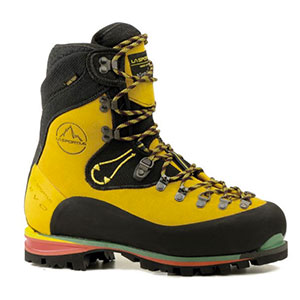
Mountaineering Boots
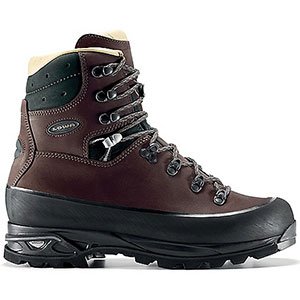
Backpacking Boots
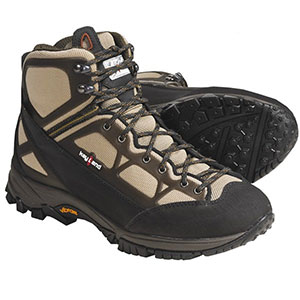
Hiking Boots

+14 more types
Review Your Outdoor Gear
If you've found this site helpful — or if we've missed something important — please consider paying it forward by some of your favorite outdoor gear.
Why? From professional gearheads to outdoor novices, everyone has an important point of view to contribute. will support the outdoor community and help others find the best gear.
Trailspace reviewers are outdoor enthusiasts like you: hikers, climbers, paddlers, backcountry skiers, and trail runners who share our experiences with the gear and clothing we rely on to get outside. Learn more about Trailspace

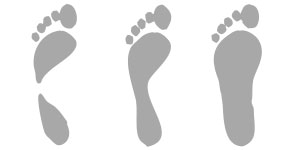
 The removable footbeds, or insoles, sold with footwear are often flimsy. Consider replacing them with custom versions. Insoles are offered in stability, neutral, or motion-control versions and for low to high volume feet or shoes.
The removable footbeds, or insoles, sold with footwear are often flimsy. Consider replacing them with custom versions. Insoles are offered in stability, neutral, or motion-control versions and for low to high volume feet or shoes.




